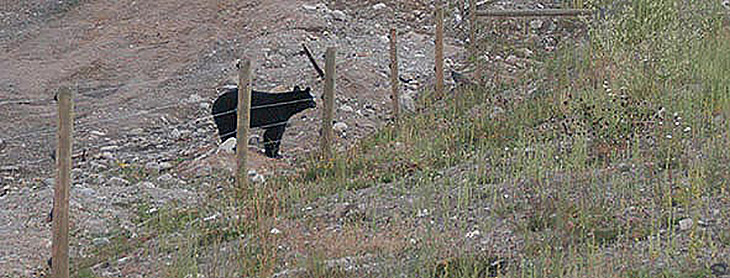Download your Beginner’s Guide: Montana Fish, Wildlife and Parks Electric Fencing to Deter Bears.
Electric fencing is a relatively simple and cost-effective way to secure bear attractants that cannot be removed or otherwise contained and is a proven method for protecting bears, and other wildlife, from becoming non-natural food conditioned. Electric fences are easily adapted to a variety of situations – fruit & berry orchards, urban hen coops, beehives, livestock enclosures, grain sheds, landfills, hunting and backpacking camps, even high-use visitor areas and campgrounds e.g., Lake Louise Campground – and are relatively easy to maintain and economical to install.
Depending on what is being protected, fences can be installed permanently or temporarily. Long-term wildlife attractants, such as landfills, will require a substantial permanent fence. On the other hand, residents with fruit trees, berry bushes or vegetable gardens can opt for a portable, lightweight fence that can be removed once harvesting is completed.
Electric fences deter bears by providing an electric shock when the animal touches the charged wires. Under normal operating conditions, an electric fence functions as an incomplete (open) circuit with repeating pulses of electricity generated by the energizer sent through the charged wires of the fence. When an animal touches a charged wire, it grounds the fence, creating a closed circuit. An electrical pulse travels through the animal and back to the energizer, delivering a shock to the animal. While the electric shock is unpleasant to animals (and humans), it is not lethal or harmful.
An electric fence is humane, since it can only shock the animal if it persists in making contact; once the animal moves away, the displeasure stops. Being intelligent animals, bears quickly learn to avoid negative stimulus; electric fencing not only deters bears, but it teaches them to stay away.
For information on electric fencing design, safety and other considerations, WildSafeBC has Guidelines and a Checklist. Additional information can be found on their Website.
Get the quick version here:
For information on how to create a wildlife attractant bylaw, or insert wording into an existing bylaw, that includes requirements for electric fencing to protect urban chickens, beehives and other attractants, read Wildlife Attractant Bylaw & Guide.
The Interagency Grizzly Bear Committee (IGBC) provides a list of recommended permanent and temporary electric fences for use in grizzly bear country IGBC Bear-Resistant Products (refer to pgs. 27-30).
Custom Fence Installation
PO Box 1100, Penticton, BC V2A 6J9 Canada
Phone: 250-492-7090
Email: info@powerfence.ca
Website: www.powerfence.ca
206 Gordon Jones Way, High River, Alberta T1V 1M5 Canada
Phone: Toll free 1-800-652-1199 or 403-652-1932
Email: info@margosupplies.com
Website: www.margosupplies.com
Resources:
Recreation Tech Tips from US Forest Service, Specifications for Portable Electric Fence Systems as Potential Alternative Methods for Food Storage: can be found here.

